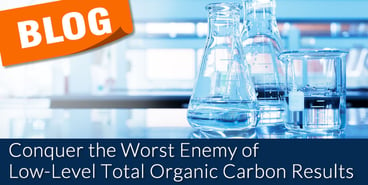 What are the three worst enemies of low-level total organic carbon (TOC) analysis? Contamination, contamination, and contamination. Why stated three times? Because contamination can come from at least three different sources. The top three ways contamination can be inadvertently introduced into a TOC analyzer are reagents, laboratory glassware, and samples.
What are the three worst enemies of low-level total organic carbon (TOC) analysis? Contamination, contamination, and contamination. Why stated three times? Because contamination can come from at least three different sources. The top three ways contamination can be inadvertently introduced into a TOC analyzer are reagents, laboratory glassware, and samples.
The main reagent for high-quality, low-level results is laboratory water. Laboratory water is used not only as a reagent, but also for cleaning and instrument dilutions. According to United States Pharmacopeia Method 643 (USP<643>), the TOC level requirement for reagent water is ≤ 0.100 mg/L. This reagent grade water is typically provided by a multi-step water filtering and purifying system. Other reagents are phosphoric acid and sodium persulfate. These are purchased through a reliable source for certified chemicals and reagents. When these chemicals are purchased, proper storage is a necessity. The date received and date opened must be closely tracked and expiration dates must be designated. Extra precautions are required when making reagents so that contaminants are not introduced into the containers.
Implementing a strict glassware cleaning procedure will minimize carbon contamination on laboratory glassware used for trace TOC determination. This procedure will apply to all glassware, containers, and closures that come in contact with samples, standards, or reagents used during TOC analyses. This includes autosampler bottles, sample vials, reagent containers, calibration standard bottles, volumetric flasks and pipettes, and all closures for these containers, including polytetrafluoroethylene (PTFE)-backed septa, plastic caps, and ground glass stoppers. The laboratory glassware cleaning solution used in this procedure is purchased from one of many laboratory supply companies. This cleaning solution is designed to completely rinse from the glassware, leaving no interfering residue.
 Sometimes samples can be high enough in TOC content to adversely affect the sample pathway of the instrument. This is where choosing the right TOC analyzer makes a difference. The Teledyne Tekmar Fusion TOC analyzer is not a contamination prone instrument. All tubing that the sample contacts is made from PTFE. This material is highly inert and resists adhesion of most types of samples. Also, due to the rinsing methodology built into the Fusion, there is virtually no carryover between samples. However, in certain environmental labs, dirty samples will be analyzed. Contribution of contaminants can easily be tracked by monitoring the reagent water results along with the acid and reagent blank results. If these values reach a level that impacts low-level results, sample tubing should be changed.
Sometimes samples can be high enough in TOC content to adversely affect the sample pathway of the instrument. This is where choosing the right TOC analyzer makes a difference. The Teledyne Tekmar Fusion TOC analyzer is not a contamination prone instrument. All tubing that the sample contacts is made from PTFE. This material is highly inert and resists adhesion of most types of samples. Also, due to the rinsing methodology built into the Fusion, there is virtually no carryover between samples. However, in certain environmental labs, dirty samples will be analyzed. Contribution of contaminants can easily be tracked by monitoring the reagent water results along with the acid and reagent blank results. If these values reach a level that impacts low-level results, sample tubing should be changed.
Real world situation
I once installed a Fusion UV/Persulfate TOC analyzer in a laboratory and was scheduled to perform an operation and performance qualification (IQ/OQ/PQ). An analysis schedule was set up on the Fusion to determine the quality of the reagent water provided by the laboratory. During analysis, when the first sample began sparging in the UV reactor, the liquid began to turn yellow and started to foam. This is definitely not normal!
Luckily, the foaming wasn’t severe and did not enter the sample gas flow-path tubing. The resulting TOC concentration was alarmingly high … especially for what the laboratory was trying to pass off as reagent grade water. So, while trying to explain to the customer that there was a serious issue with the analysis, I was thinking of how to solve the problem. My first thought was contamination. Next thought was to isolate the contamination. Another sample was analyzed, but without the addition of phosphoric acid or sodium persulfate reagent. This time the sample did not turn yellow and foam.
The customer told me they just made the reagents two days prior. I asked to see the containers of phosphoric acid and sodium persulfate which they used to prepare the reagents. The sodium persulfate looked fine. However, the 2.5 liter bottle of concentrated phosphoric acid looked dreadful! The label of the bottle was so old it was actually crumbling and falling off as it was brought to me. What little acid that remained in the bottle was light amber in color. I told the customer that we’ve found the culprit. New reagents were made using a newly opened bottle of phosphoric acid. Problem solved. Needless to say, the IQ/OQ/PQ was completed with the Fusion providing impeccable results.
Conclusion
A key element in providing quality TOC results, especially at low levels, is cleanliness. The importance of contamination-free reagents, laboratory water, and glassware cannot be overstated. Combine a stringent policy for laboratory cleanliness along with Teledyne Tekmar’s Fusion UV/Persulfate TOC analyzer for unrivalled low-level analytical performance.
Visit our website for more information on the Fusion UV/Persulfate TOC Analyzer or click the button below if you would like a quote or to have sales contact you.
